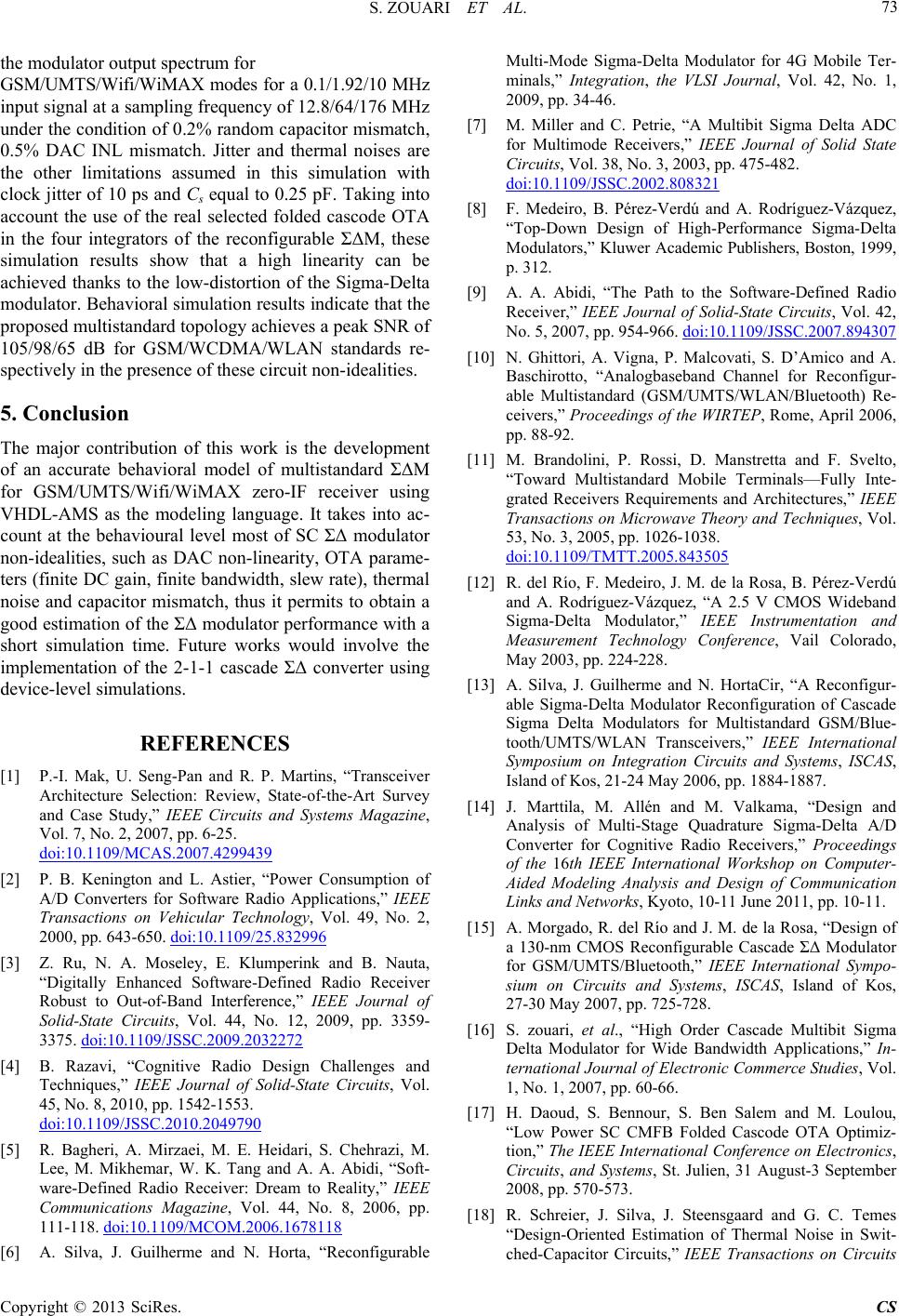
S. ZOUARI ET AL. 73
the modulator output spectrum for
GSM/UMTS/Wifi/WiMAX modes for a 0.1/1.92/10 MHz
input signal at a sampling frequency of 12.8/64/176 MHz
under the condition of 0.2% random capacitor mismatch,
0.5% DAC INL mismatch. Jitter and thermal noises are
the other limitations assumed in this simulation with
clock jitter of 10 ps and Cs equal to 0.25 pF. Taking into
account the use of the real selected folded cascode OTA
in the four integrators of the reconfigurable ΣΔM, these
simulation results show that a high linearity can be
achieved thanks to the low-distortion of the Sigma-Delta
modulator. Behavioral simulation results indicate that the
proposed multistandard topology achieves a peak SNR of
105/98/65 dB for GSM/WCDMA/WLAN standards re-
spectively in the presence of these circuit non-idealities.
5. Conclusion
The major contribution of this work is the development
of an accurate behavioral model of multistandard ΣΔM
for GSM/UMTS/Wifi/WiMAX zero-IF receiver using
VHDL-AMS as the modeling language. It takes into ac-
count at the behavioural level most of SC ΣΔ modulator
non-idealities, such as DAC non-linearity, OTA parame-
ters (finite DC gain, finite bandwidth, slew rate), thermal
noise and capacitor mismatch, thus it permits to obtain a
good estimation of the ΣΔ modulator performance with a
short simulation time. Future works would involve the
implementation of the 2-1-1 cascade ΣΔ converter using
device-level simulations.
REFERENCES
[1] P.-I. Mak, U. Seng-Pan and R. P. Martins, “Transceiver
Architecture Selection: Review, State-of-the-Art Survey
and Case Study,” IEEE Circuits and Systems Magazine,
Vol. 7, No. 2, 2007, pp. 6-25.
doi:10.1109/MCAS.2007.4299439
[2] P. B. Kenington and L. Astier, “Power Consumption of
A/D Converters for Software Radio Applications,” IEEE
Transactions on Vehicular Technology, Vol. 49, No. 2,
2000, pp. 643-650. doi:10.1109/25.832996
[3] Z. Ru, N. A. Moseley, E. Klumperink and B. Nauta,
“Digitally Enhanced Software-Defined Radio Receiver
Robust to Out-of-Band Interference,” IEEE Journal of
Solid-State Circuits, Vol. 44, No. 12, 2009, pp. 3359-
3375. doi:10.1109/JSSC.2009.2032272
[4] B. Razavi, “Cognitive Radio Design Challenges and
Techniques,” IEEE Journal of Solid-State Circuits, Vol.
45, No. 8, 2010, pp. 1542-1553.
doi:10.1109/JSSC.2010.2049790
[5] R. Bagheri, A. Mirzaei, M. E. Heidari, S. Chehrazi, M.
Lee, M. Mikhemar, W. K. Tang and A. A. Abidi, “Soft-
ware-Defined Radio Receiver: Dream to Reality,” IEEE
Communications Magazine, Vol. 44, No. 8, 2006, pp.
111-118. doi:10.1109/MCOM.2006.1678118
[6] A. Silva, J. Guilherme and N. Horta, “Reconfigurable
Multi-Mode Sigma-Delta Modulator for 4G Mobile Ter-
minals,” Integration, the VLSI Journal, Vol. 42, No. 1,
2009, pp. 34-46.
[7] M. Miller and C. Petrie, “A Multibit Sigma Delta ADC
for Multimode Receivers,” IEEE Journal of Solid State
Circuits, Vol. 38, No. 3, 2003, pp. 475-482.
doi:10.1109/JSSC.2002.808321
[8] F. Medeiro, B. Pérez-Verdú and A. Rodríguez-Vázquez,
“Top-Down Design of High-Performance Sigma-Delta
Modulators,” Kluwer Academic Publishers, Boston, 1999,
p. 312.
[9] A. A. Abidi, “The Path to the Software-Defined Radio
Receiver,” IEEE Journal of Solid-State Circuits, Vol. 42,
No. 5, 2007, pp. 954-966. doi:10.1109/JSSC.2007.894307
[10] N. Ghittori, A. Vigna, P. Malcovati, S. D’Amico and A.
Baschirotto, “Analogbaseband Channel for Reconfigur-
able Multistandard (GSM/UMTS/WLAN/Bluetooth) Re-
ceivers,” Proceedings of the WIRTEP, Rome, April 2006,
pp. 88-92.
[11] M. Brandolini, P. Rossi, D. Manstretta and F. Svelto,
“Toward Multistandard Mobile Terminals—Fully Inte-
grated Receivers Requirements and Architectures,” IEEE
Transactions on Microwave Theory and Techniques, Vol.
53, No. 3, 2005, pp. 1026-1038.
doi:10.1109/TMTT.2005.843505
[12] R. del Río, F. Medeiro, J. M. de la Rosa, B. Pérez-Verdú
and A. Rodríguez-Vázquez, “A 2.5 V CMOS Wideband
Sigma-Delta Modulator,” IEEE Instrumentation and
Measurement Technology Conference, Vail Colorado,
May 2003, pp. 224-228.
[13] A. Silva, J. Guilherme and N. HortaCir, “A Reconfigur-
able Sigma-Delta Modulator Reconfiguration of Cascade
Sigma Delta Modulators for Multistandard GSM/Blue-
tooth/UMTS/WLAN Transceivers,” IEEE International
Symposium on Integration Circuits and Systems, ISCAS,
Island of Kos, 21-24 May 2006, pp. 1884-1887.
[14] J. Marttila, M. Allén and M. Valkama, “Design and
Analysis of Multi-Stage Quadrature Sigma-Delta A/D
Converter for Cognitive Radio Receivers,” Proceedings
of the 16th IEEE International Workshop on Computer-
Aided Modeling Analysis and Design of Communication
Links and Networks, Kyoto, 10-11 June 2011, pp. 10-11.
[15] A. Morgado, R. del Río and J. M. de la Rosa, “Design of
a 130-nm CMOS Reconfigurable Cascade ΣΔ Modulator
for GSM/UMTS/Bluetooth,” IEEE International Sympo-
sium on Circuits and Systems, ISCAS, Island of Kos,
27-30 May 2007, pp. 725-728.
[16] S. zouari, et al., “High Order Cascade Multibit Sigma
Delta Modulator for Wide Bandwidth Applications,” In-
ternational Journal of Electronic Commerce Studies, Vol.
1, No. 1, 2007, pp. 60-66.
[17] H. Daoud, S. Bennour, S. Ben Salem and M. Loulou,
“Low Power SC CMFB Folded Cascode OTA Optimiz-
tion,” The IEEE International Conference on Electronics,
Circuits, and Systems, St. Julien, 31 August-3 September
2008, pp. 570-573.
[18] R. Schreier, J. Silva, J. Steensgaard and G. C. Temes
“Design-Oriented Estimation of Thermal Noise in Swit-
ched-Capacitor Circuits,” IEEE Transactions on Circuits
Copyright © 2013 SciRes. CS